Galloping in Europe: the journey of the "Formula Student" from the Czech Republic to Moscow
Most recently, we talked about, " How we collected the car in Baumanka ... ". Our team participating in Formula SAE, international engineering competitions for student teams to create Formula racing cars, designed cars using digital modeling technology, drove with him to competitions in the Czech Republic and took silver at international competitions in Moscow. And now we will tell everything in detail.

Every year new guys come to our team with a desire to put the theoretical knowledge in the field of mechanical engineering into practice. We have formed the updated Bauman Racing Team for participation in the Formula Student competition at the beginning of the 2016/2017 academic year. Of course, we still have participants from past years who have learned a lot and are able to share experience with newcomers. Those in the team - 20 people. Always ready to help with practical advice and graduates. To get into the team, one desire is not enough. We have a kind of "qualifying" selection. In addition, new members of the Bauman Racing Team must perform a test task - to make or design any part in modern tools (for example, Siemens NX). To those who pass this stage, we are ready to show (or help to improve qualifications) how to use PLM technologies: for example, to create an electronic product mock-up (EMR), as we were taught by partners from LANIT.

This is our big team, and for the head of the Bauman Racing Team Dmitry Onishchenko (in the first row to the right) - also the family. The two children in the photo are his son and daughter.
')
After updating the team, we started to create a new car, which at first was not too similar not only to a racing car, but also to a vehicle in general.
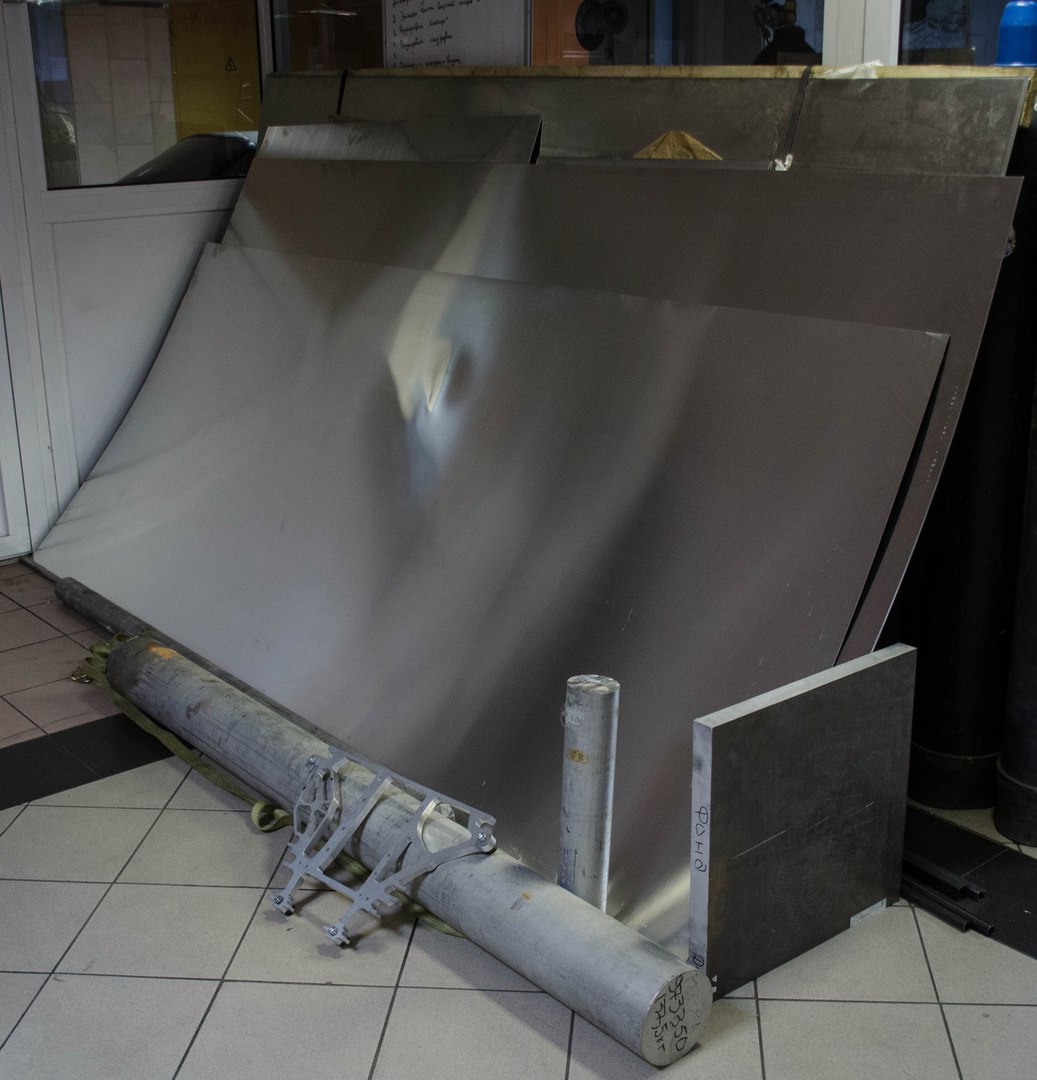
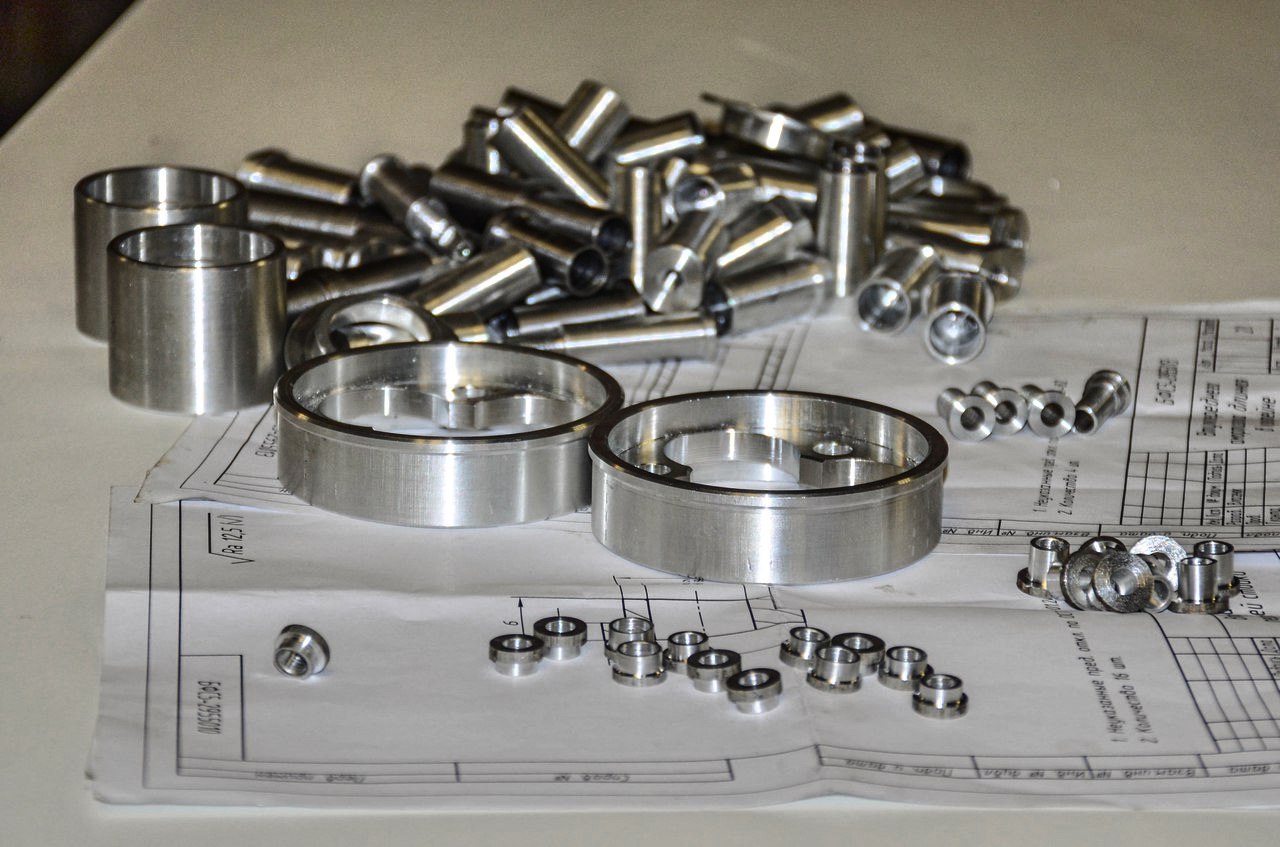

The volume of materials and the number of purchased products (bolts, nuts, rivets) would be difficult to predict in advance if we did not have a digital model. By the way, digital technologies make it possible to determine many different nuances without the need to conduct experiments: for example, you can calculate the total weight of plastic parts or the weight of a wire winding, test the machine components and suspension lever for strength, and also find out how the parts behave on different types of roads.

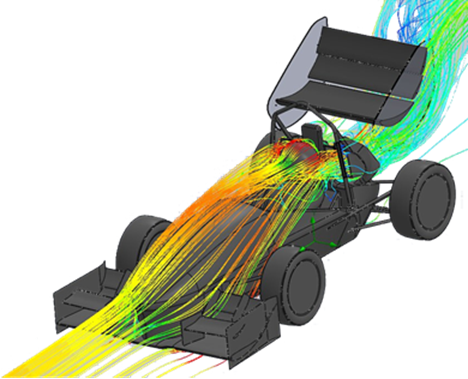
Again, modern technologies helped us to predict the behavior of individual machine systems. We simulated the reaction of the chassis to the various actions of the pilot, the effect of these actions on the engine and the entire electrical circuit. Without creating a digital twin, it would be impossible to do this. But the system created by us is not perfect and needs some work (why - you will read further).
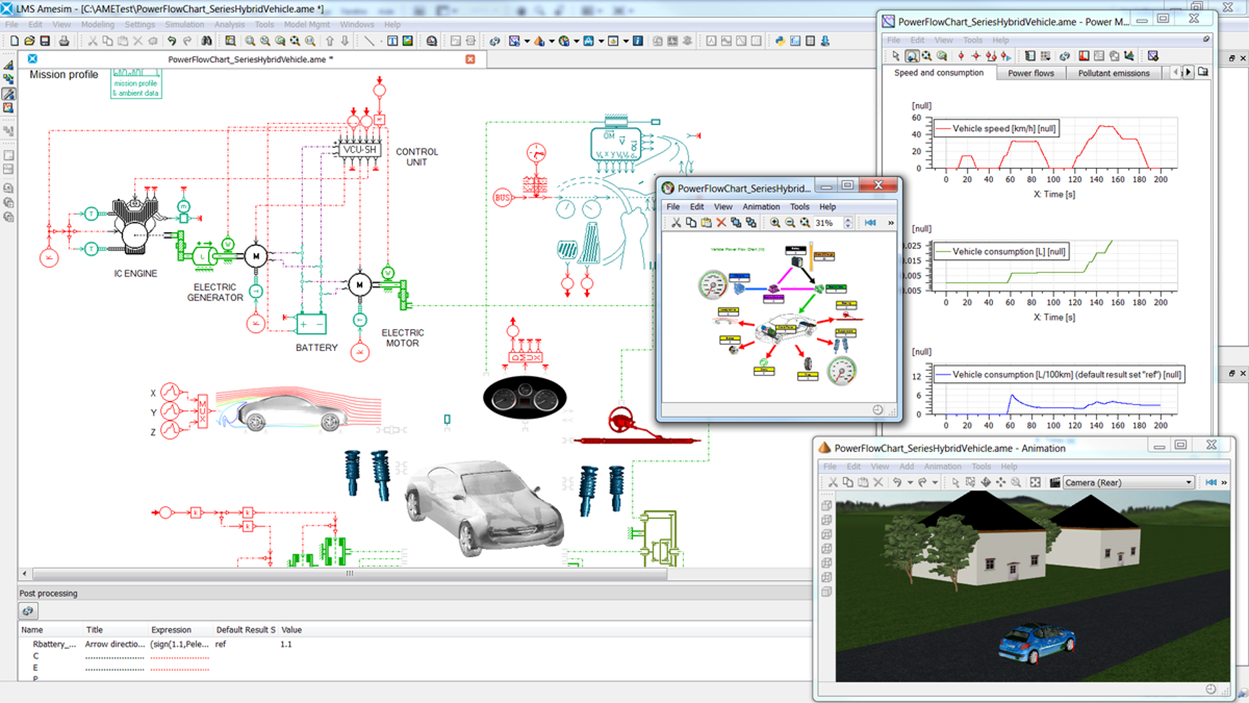
Of course, for professional sports, it will be necessary to confirm the digital tests with full-scale experiments, but for the "Formula Student" we had enough of these calculations.
If the right improvised tool is attached to the digital technologies, then an experienced mini-production can turn out.
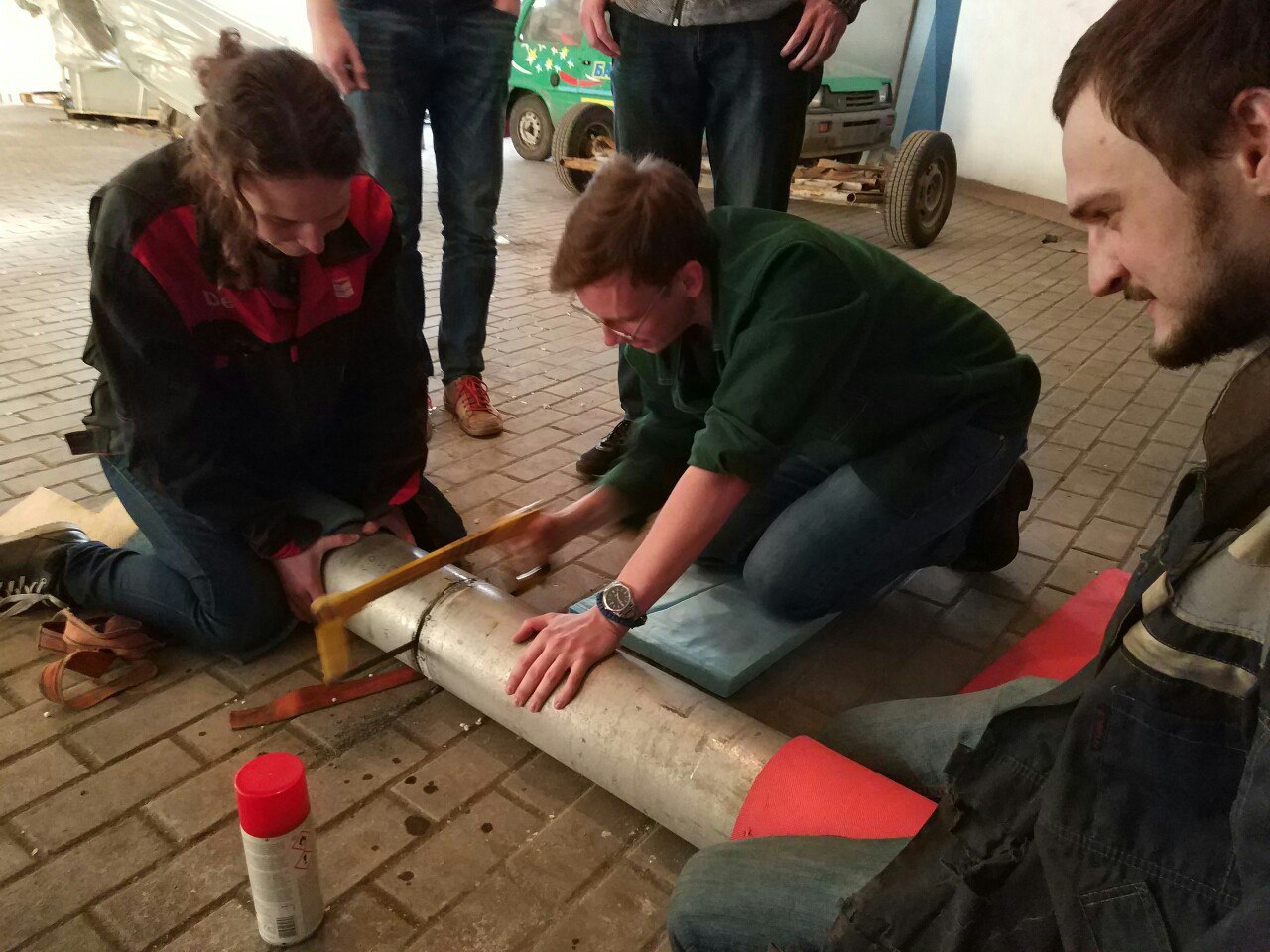
This year it took us 7 months to build a car from the “stocking” state. This is a month less than last year. And this is despite the fact that we did not use the capabilities of the PLM system 100%. There are still several training cycles planned from LANIT for requirements management and collaboration modules, but this is not the case now. As a basis, we took the previous version of our car. By optimizing some of the nodes and adding digital calculations (strength of parts and structures), we’ll get the same digital counterpart of our new car.


Actually, thanks to this, we managed to reduce the production time: the system allowed us to create a physical object in a virtual environment in a single digital platform. We could see each other's work and make edits at all stages of creating a car.
And our car is ready to go to the Formula Student competition in the Czech Republic - Formula Student Czech Republic .

It remains to settle the organizational issues and do what is always postponed for “later” - to weld the jack.

The jack is needed for the convenience of car maintenance before starting or in line. Thanks to him, you can, without exerting additional effort, access to any parts of the car. The design of the jack is a flight of imagination of future engineers, since it does not have special requirements for loads and safety.
As soon as the preparations were over, we plunged our car into a "technical" and moved to the Czech Republic.
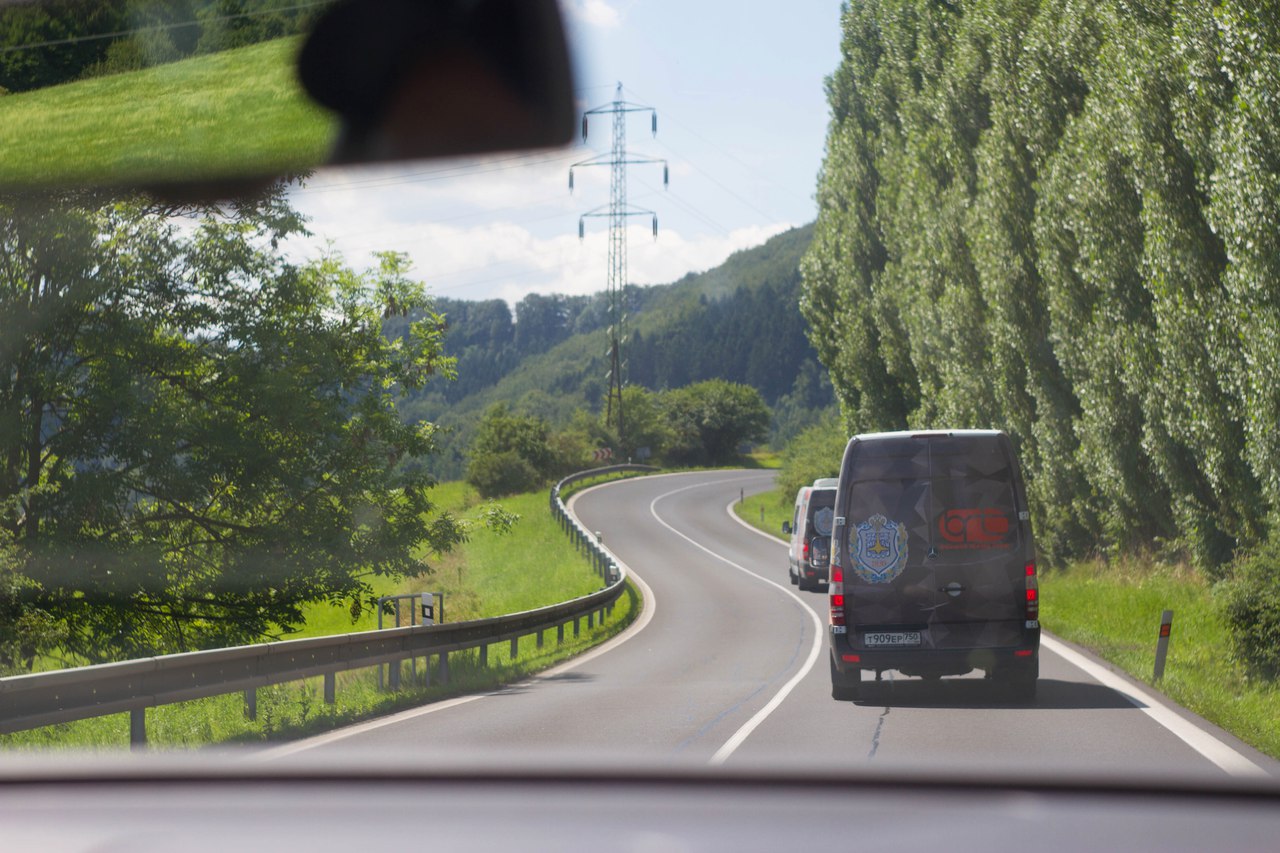
We were waiting. The organizers and volunteers did a great job to make more than 500 team members feel comfortable from early morning until late at night: they prepared the track and boxes for the participants to live in.

 A source
A source
These sunny guys met 37 teams in the 1C category (Poland - 6 teams, Czech Republic - 6, Germany - 6, England - 4, Russia - 3, Greece - 2 and one each from Turkey, Serbia, France and Hungary) and 14 teams in categories 1E (Germany - 6, Italy, Spain, Portugal, Belgium, Czech Republic, Estonia and Finland - one by one).
As we wrote in the previous article, the level of training of teams and their technical equipment are completely different. Everyone chooses design tools (CAD) convenient for them, calculation tools (CAE), few use system engineering tools to predict machine behavior (1D). All somehow study modern tools, collaboration platforms (PDM), but due to very tight deadlines, not everyone is willing to waste precious time on the introduction of these technologies. In our experience, we can say that the introduction on our own is a disadvantageous undertaking. Only together with our partners, we were able to overcome the barriers (the complexity of self-study, laziness, lack of understanding of the feasibility of implementation) and save time and nerves of our children.
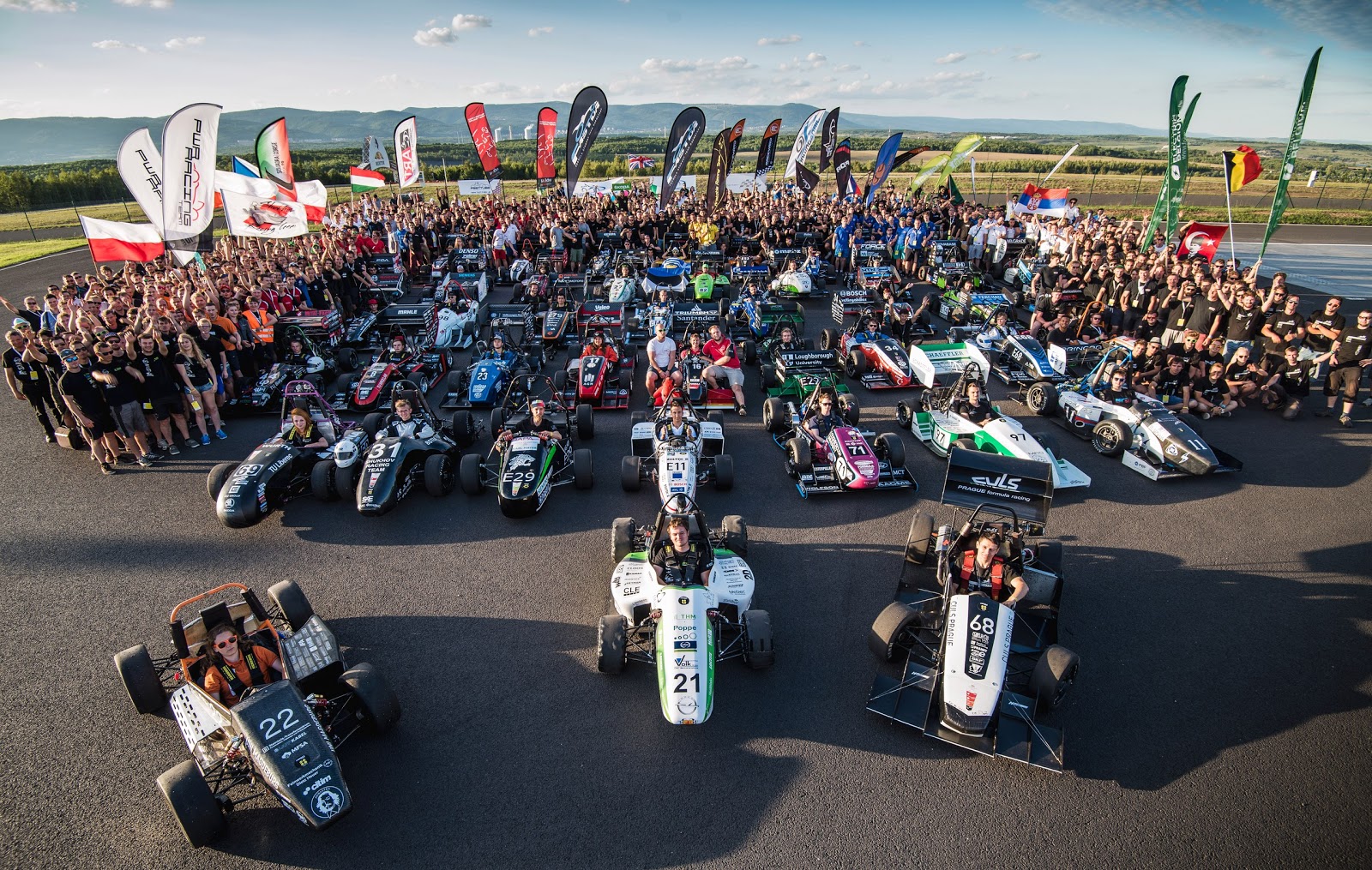 A source
A source
What was the stage for us in the Czech Republic? On the first day, everyone was assembling the cars and preparing for the technical inspection scheduled for the next day.

A source

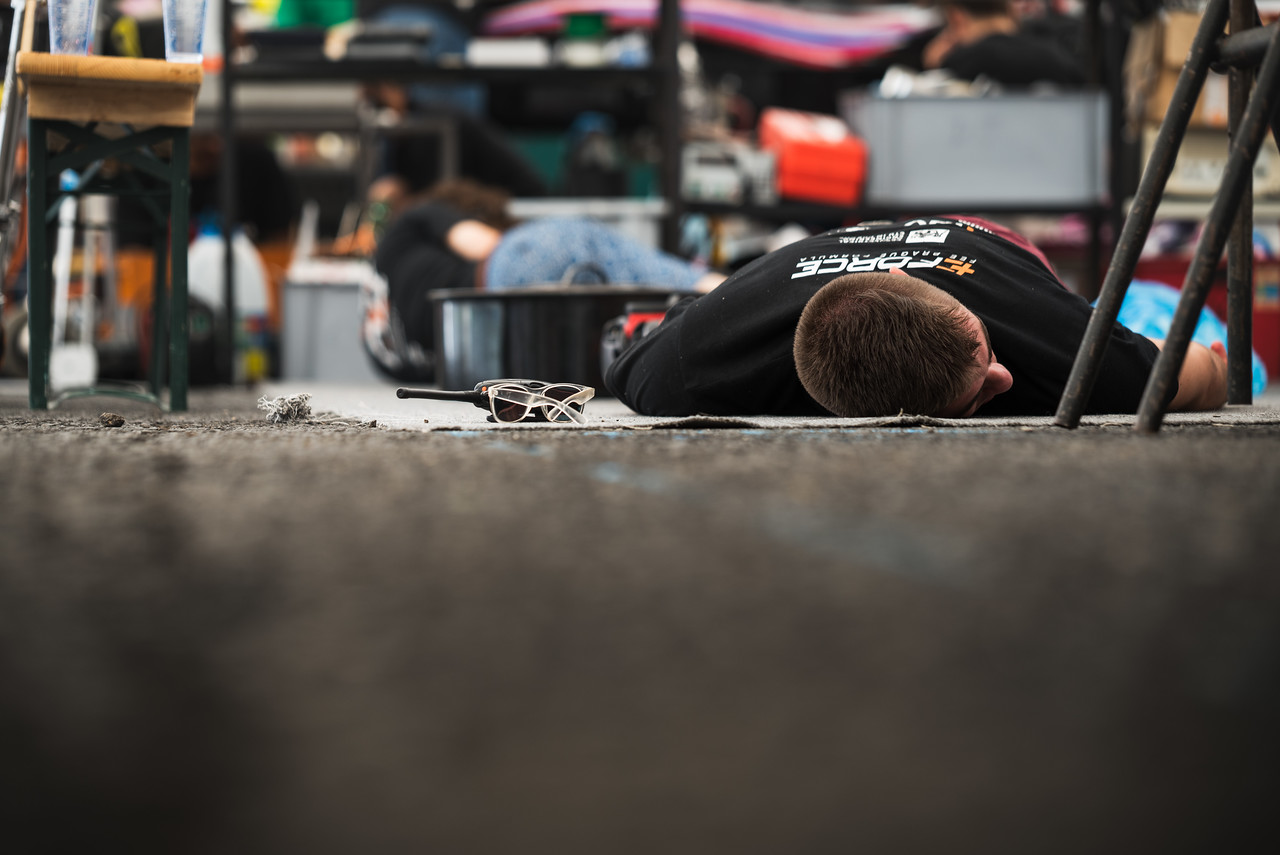
A source
Sometimes fatigue prevailed. But the thing had to finish.

The second day began with the preparation of machines for technical inspection. I had to even knock in line.
 A source
A source
Together with us, the guys from Estonia and Germany “sunbathed”.

Later in the evening, we still reached the technical inspection. The judges made three small observations (and nothing to talk about), which we eliminated in an hour.
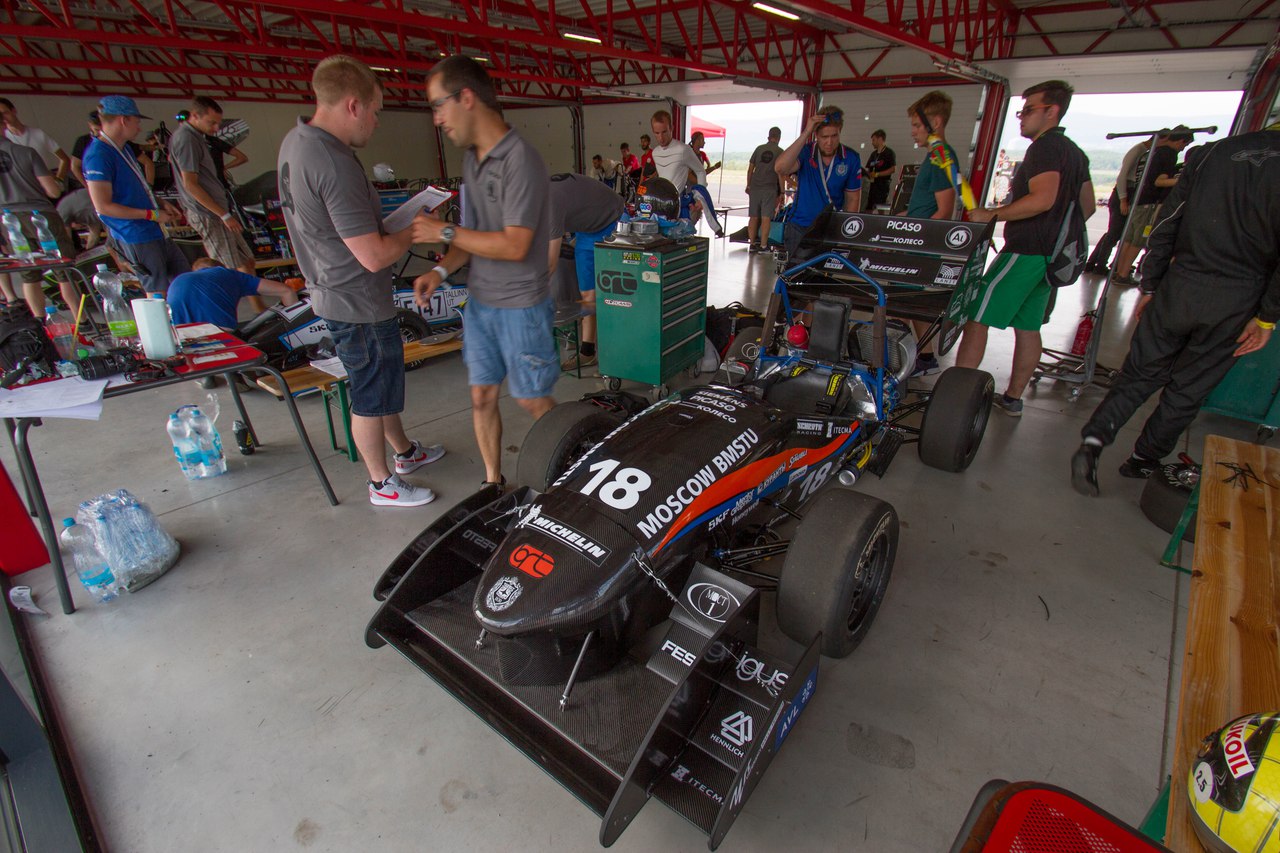
Separately, cars were checked for noise. This is where the jack came in handy:

The noise test is one of the obligatory stages of technical inspection. According to the regulations, the car on the paddock - a special place for the deployment of motor command teams - must move without the engine turned on, and in order to transport it, you need a “quick jack”. This testing can also be modeled using the digital twin. Products from CD-Adapco ( now included in the Siemens PLM Software product portfolio ) allow for acoustic analysis. But we have not yet reached such a degree of automation.
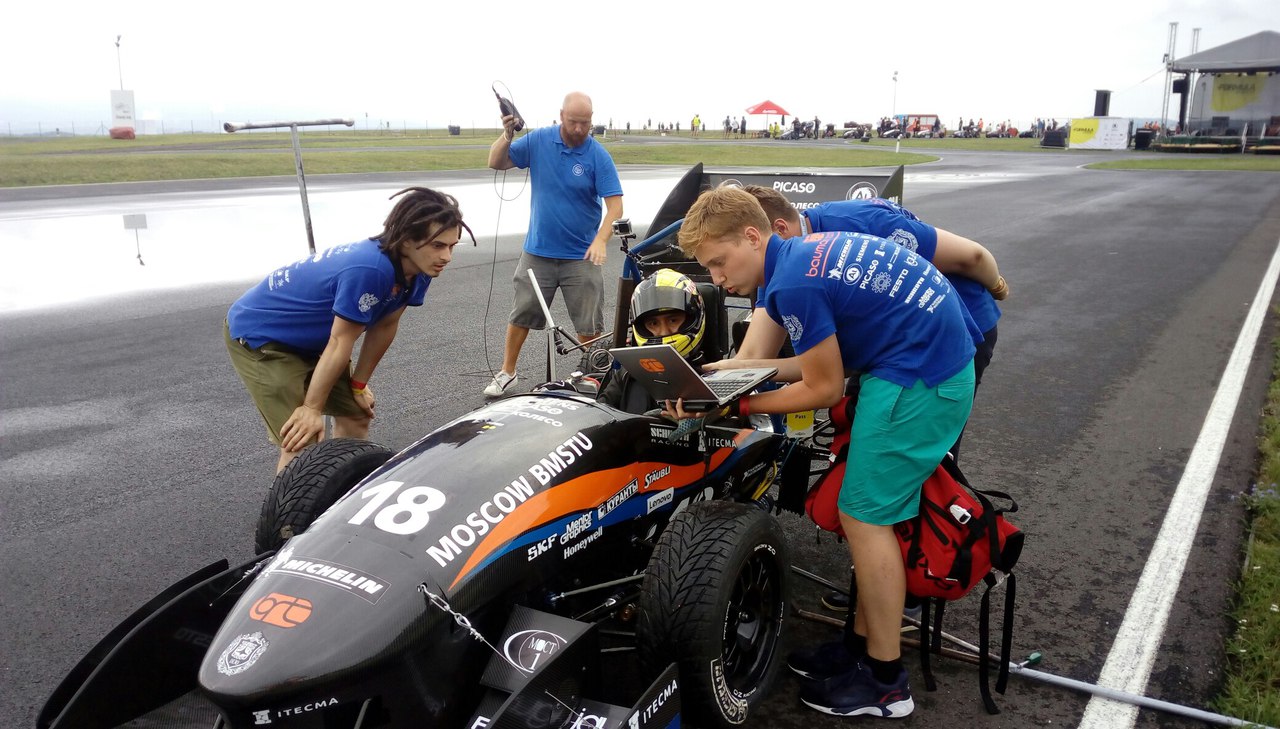
An important test is to roll over. The car on a special device is tilted at an angle of 45 degrees and the presence of leaks in the systems is observed. After that, the angle of inclination is increased to 60 degrees in order to check the weight distribution and stability of the machine.

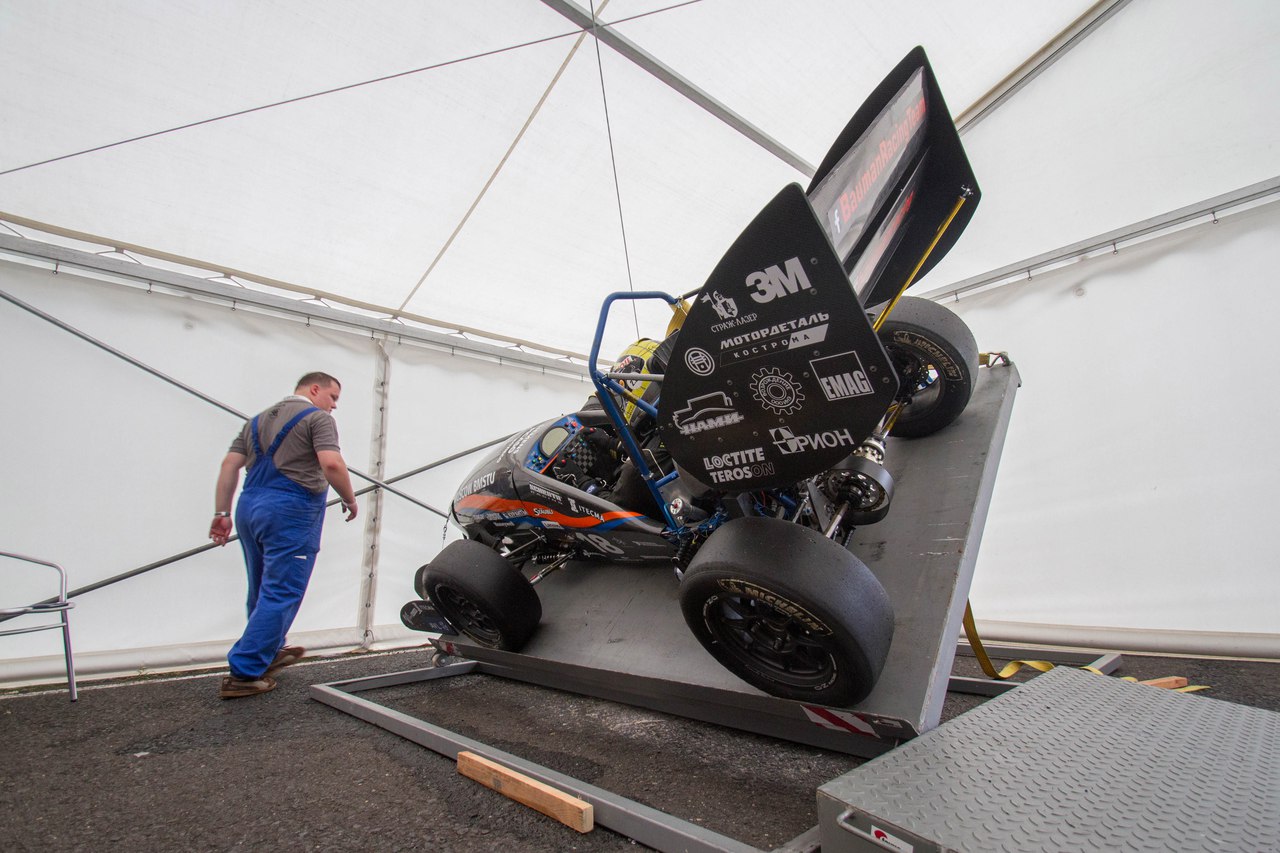
Sometimes it is useful to look at the world from a different angle.
After the completion of technical checks, everyone began to prepare for dynamic disciplines. But first it was necessary to overcome a series of static tests - Design Event, Cost Report and Business Plan Presentation.
During the Design Event it is necessary to prove to the judges that the solutions applied are justified and better than those of all other teams. This is a task for engineers.

And while technical experts substantiate the modernization of automobile units, the marketing department’s “team” submits a business plan to the jury - often professional automakers. Under the terms of the competition, calculations must be made for the production of thousands of machines made from scratch using the technologies that the team applied.
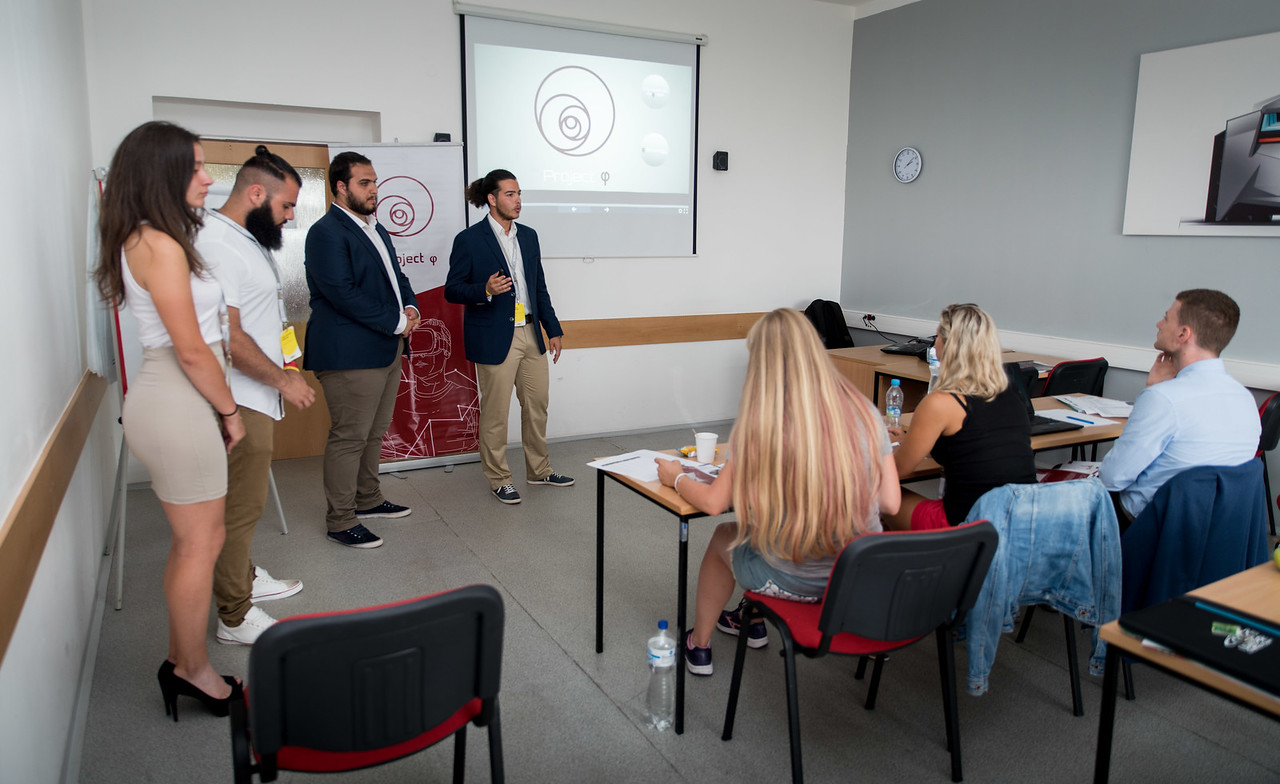
A source
These are competitors. But we also stood before the judges, only so busy with the work that the photos did not. Some participants used virtual reality technology. In the helmet of the judge do not look so strict.

A source
After completion of all technical checks and static tests, the most entertaining part of the competition begins - dynamic disciplines and race.
 A source
A source
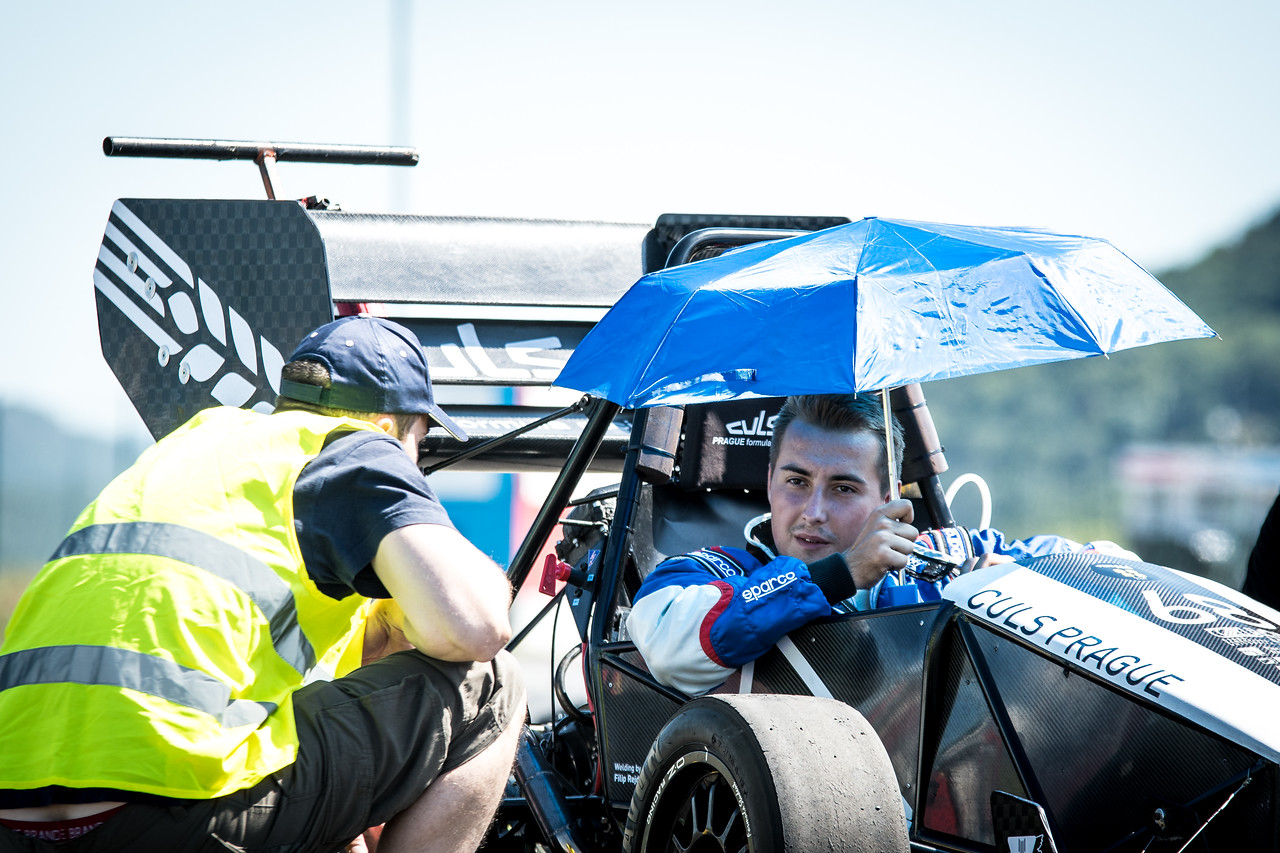
A source
The first stage is the acceleration test. Our car showed good results: acceleration of 0-100 km / h - 4 seconds. The maximum speed is 170 km / h. And this with a weight of 200 kg. When compared with the BMW M3 ... However, it is better to see once:
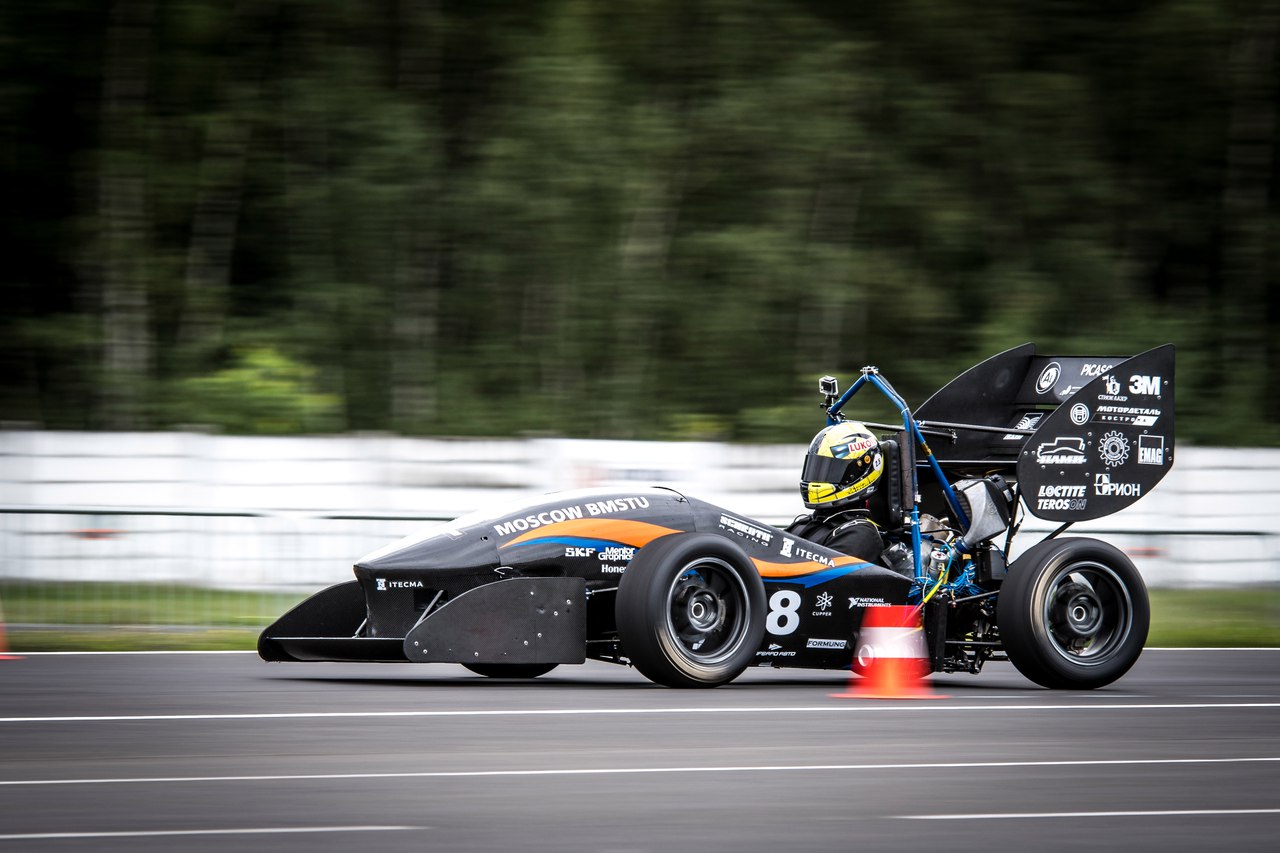

A source
With such support, contestants sought to squeeze the maximum out of the car. While on one track they were speeding up, on the other - the G8s were winding up. When both disciplines ended, the organizers took a break to build an autocross track, which served as a pass to the world of “big sports” - a race for endurance.
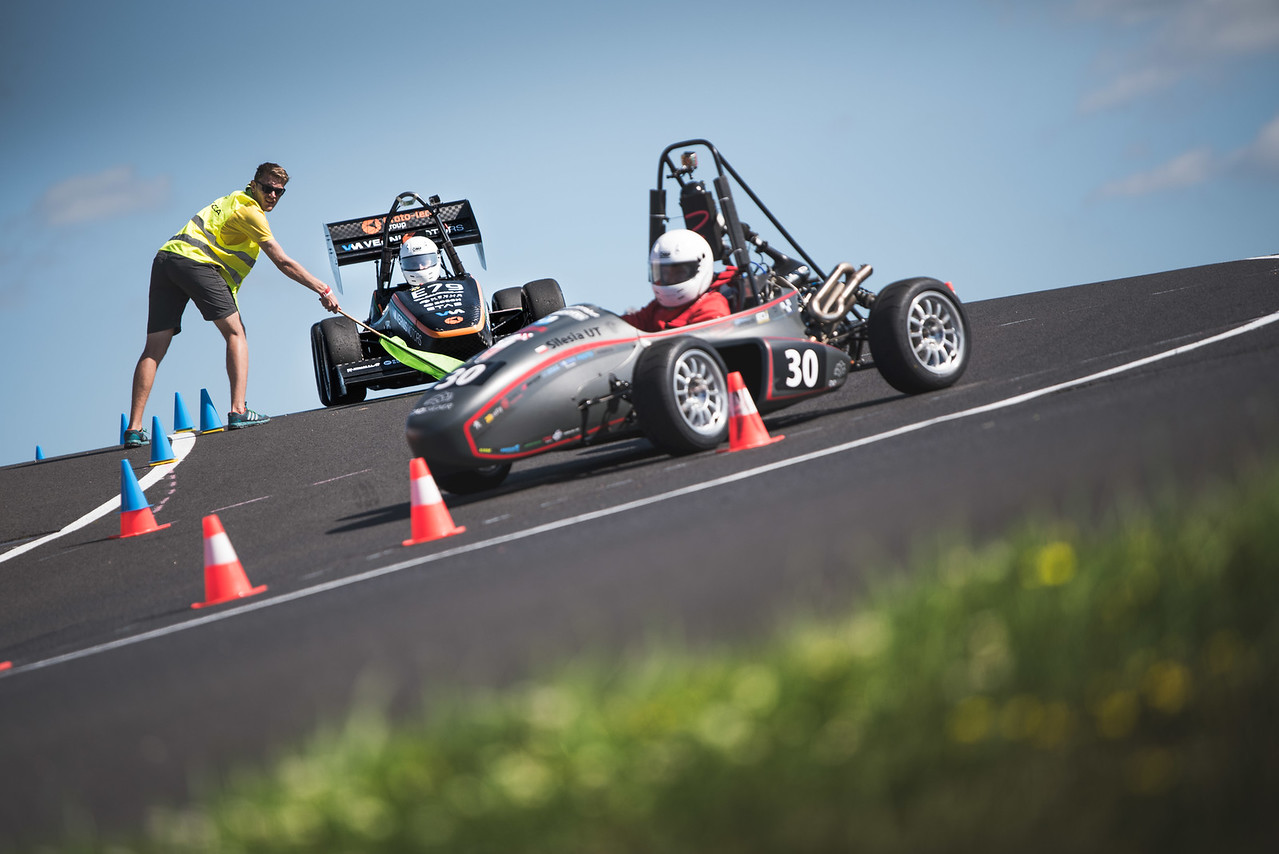
A source
By the way, the pilot of our car is also a Bauman student, as required by the rules of Formula SAE, a kart driver with a long track record. We offer a test to everyone who comes to us for a pilot’s job: if you overtake our pilots, let’s drive the car.
In the endurance race, our car showed excellent lap times.
Unfortunately, on the sixth lap, the cooling system hose could not stand, the water splashed out onto the hot engine, releasing a spectacular column of steam, and in the absence of cooling the oil system and the entire engine began to overheat. The result - we got off the track. By the end of the day the winners were determined.
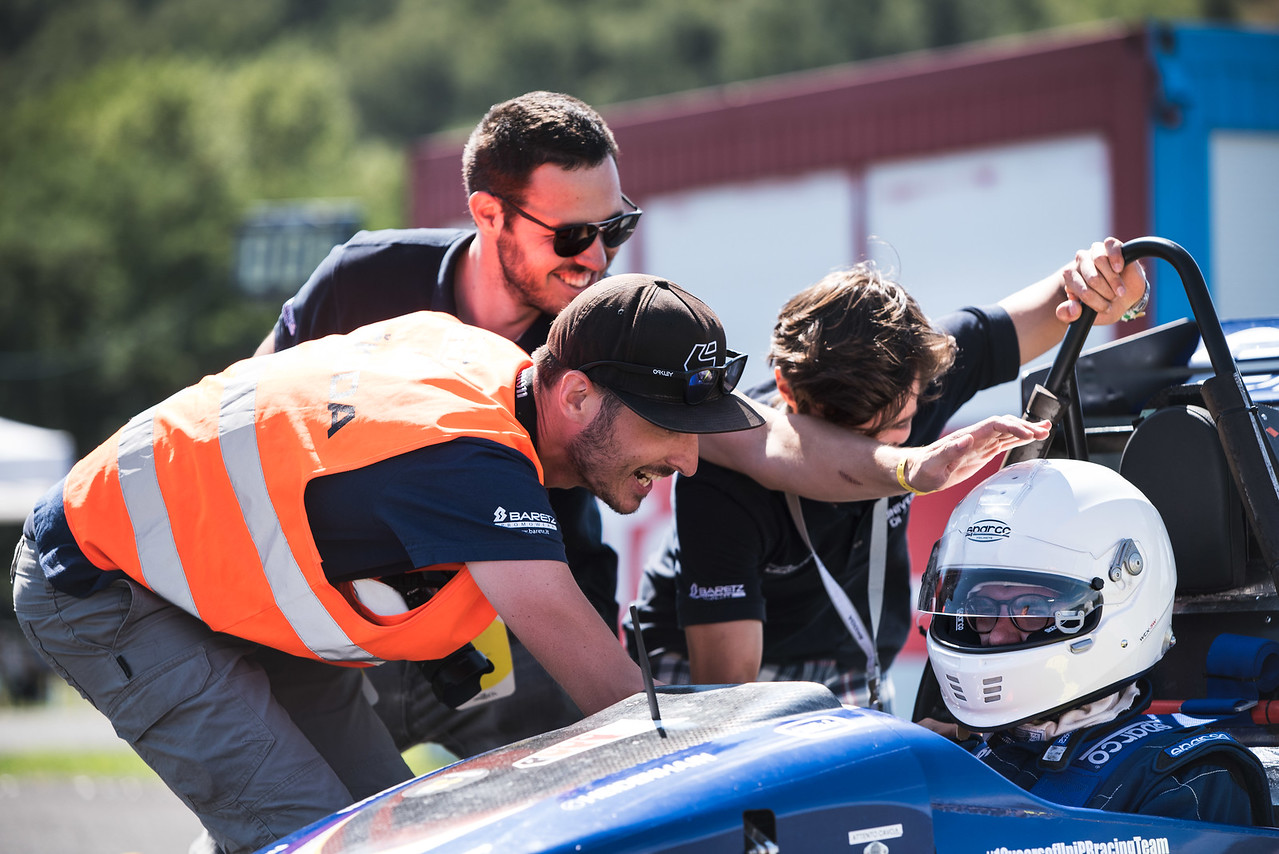
A source
The team from the University of Brno, Czech Republic won in our class. Unfortunately, we were left without awards.

A source
We met with colleagues from Czech Brno at the Formula Student Moscow stage, which took place in late September in the capital Gorky Park. A total of 10 Russian teams and two foreign teams participated - in addition to Brno, a team from Tallinn (Estonia) came to Moscow. Unfortunately, their cars remained at the border, and the teams participated only in static disciplines.
The first day of the competition was traditionally assigned to the technical inspection. We again passed the technical inspection one of the most recent. The cars were examined by former participants of the world's best Formula Student teams — Delft and GFR. No one expected it to be easy. Nevertheless, although we started last, we were one of the first to complete the inspection and began to calmly prepare for the next day, where static disciplines, acceleration tests and autocross waited for us. Due to the nature of the route, the organizers had to cancel the G8.
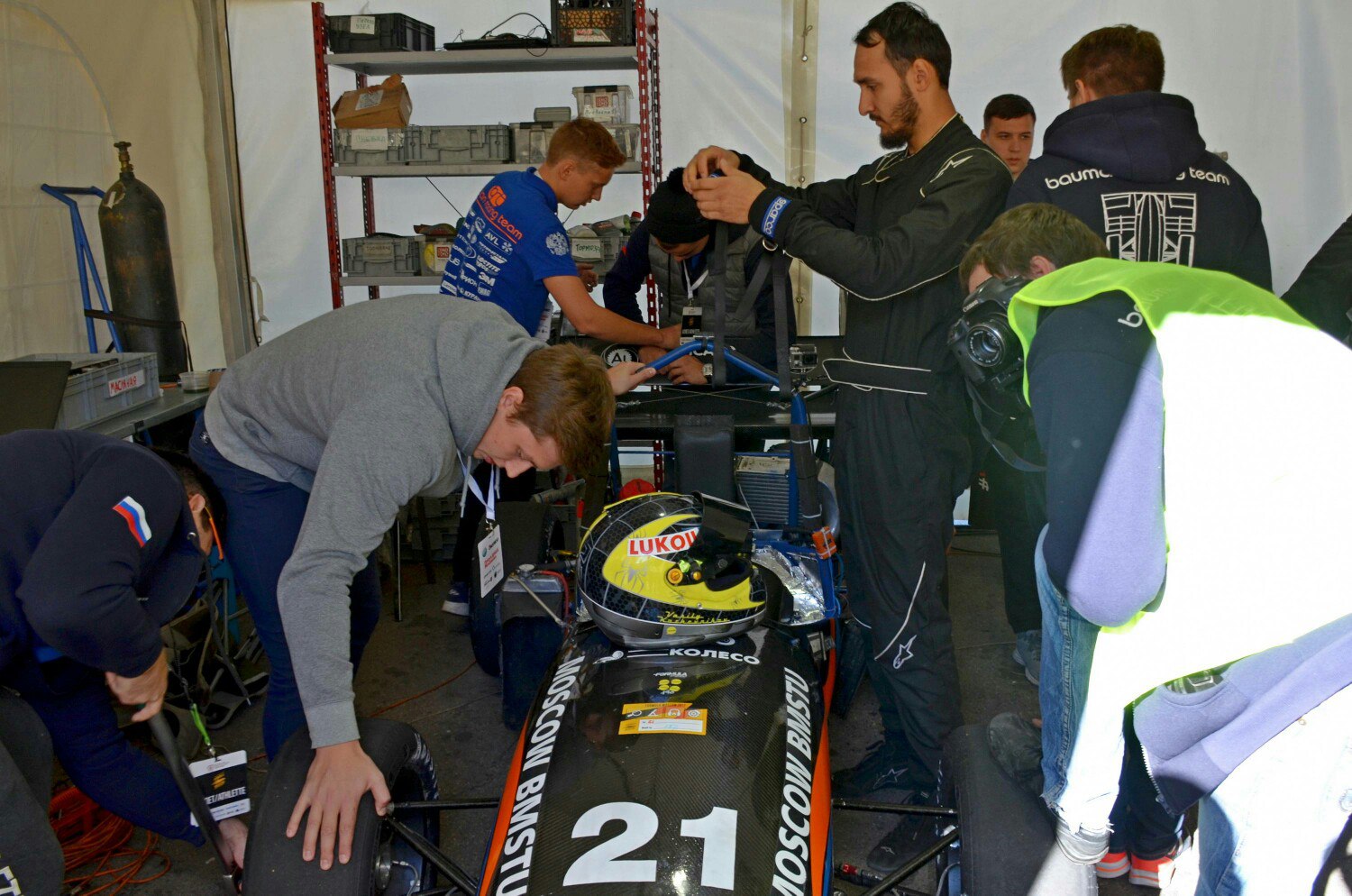
The next day, the acceleration test began right from the territory of the team boxes, which gave a special piquancy to the start and made it, in my opinion, the most spectacular among all the Formula Student events. We took the second place, and in the autocross - the third. The protection of the structure was a little worse, but thanks to the cost report, the third step of the pedestal became ours.
Final day of competition. The main event is a race for endurance. A feature of the track for this competition was its length and configuration - only 200 meters and almost an oval, in which the pilots had to cut 30 laps, fighting not so much for the best time, but with boredom.

But everything turned out exactly the opposite. Check-in was very dynamic, and the gathering was recorded only for the team from Belgorod. Our car showed excellent results on the circle. On one of the bends, part of the front wing of the car touched a cone: the wing broke down and broke off. The organizers noticed a breakdown only after a few laps, the arrival for forced repairs and the decision of the marshals to release us back onto the track took too long - as much as 50 seconds! This was another item in our "knowledge base" (Teamcenter), for the subsequent more detailed calculation of the design of the wing. Since we have set up a connection between the design model (NX) and the calculated one (Simcenter), it will be much easier for us to calculate this node in detail and take this error into account when creating the next machine.

As a result, the leader was the team of the Peoples' Friendship University of Russia, we received well-deserved silver, and the bronze went to the students of the Moscow Polytechnic University.
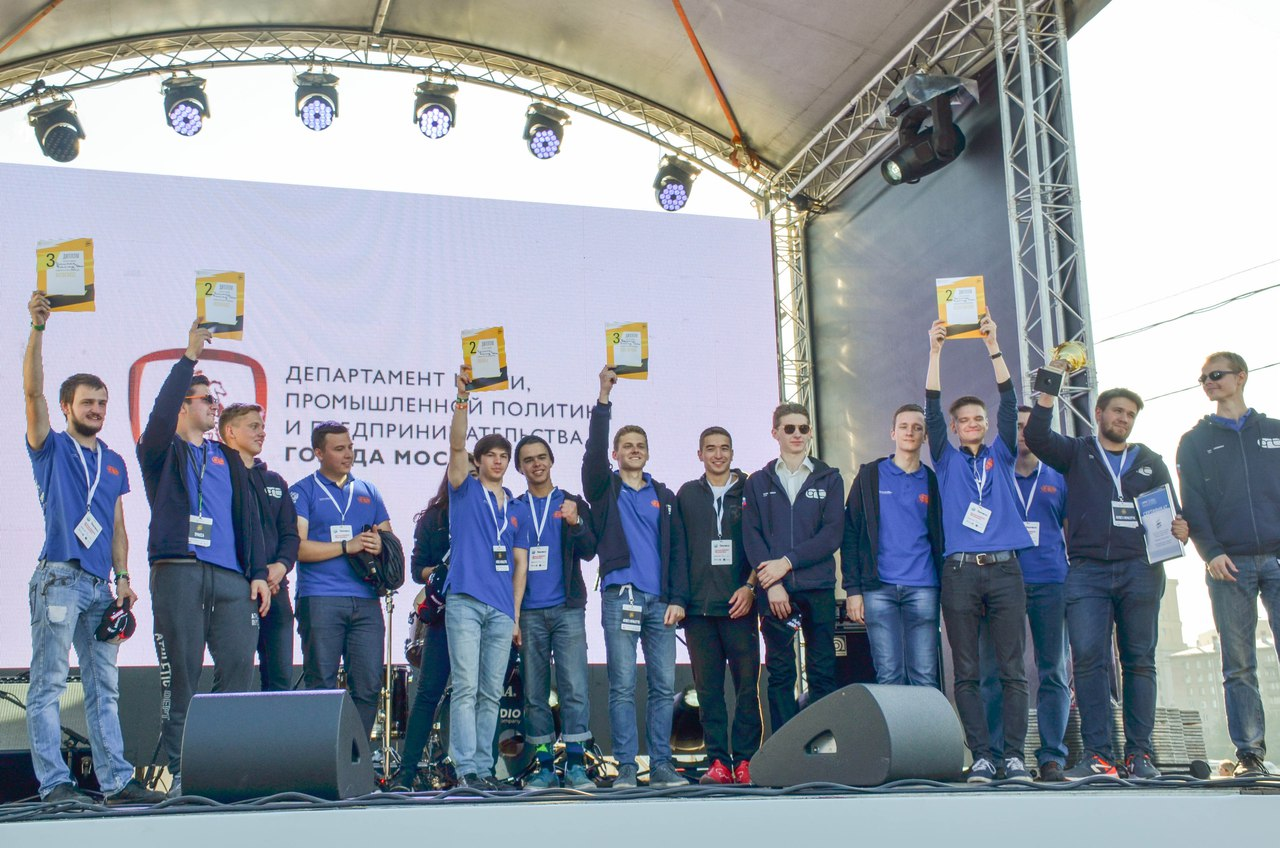

Competitions are over, and we are recruiting a team again. Very soon, work will begin on a new car, but for now the guys are learning, studying Teamcenter, NX, performing test tasks and thinking about how to improve the car.
We can not just save the experience gained in these competitions in memory or on paper, but we can add it to our platform created on Teamcenter. For example, we added information about the cooling system hose (which let us down a bit) to the electronic layout of the car. When designing the next car, we will not forget to strengthen it, regardless of whether the new team member or our experienced "fighter" will be responsible for this part.
I hope that we will continue to delight you with our results, talk about our experience in learning new technologies with the help of our partners and LANIT in particular, and talk about the application of these technologies in combat practice.
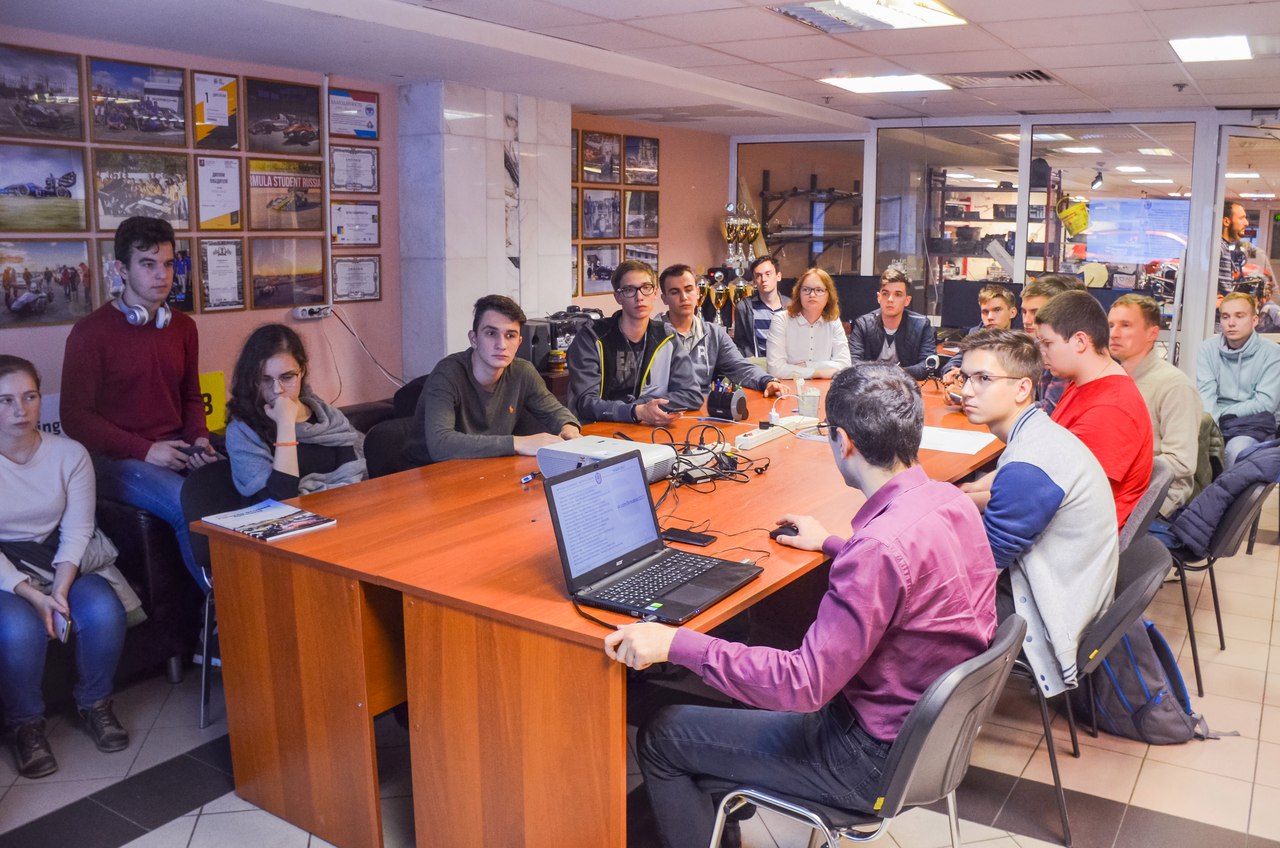
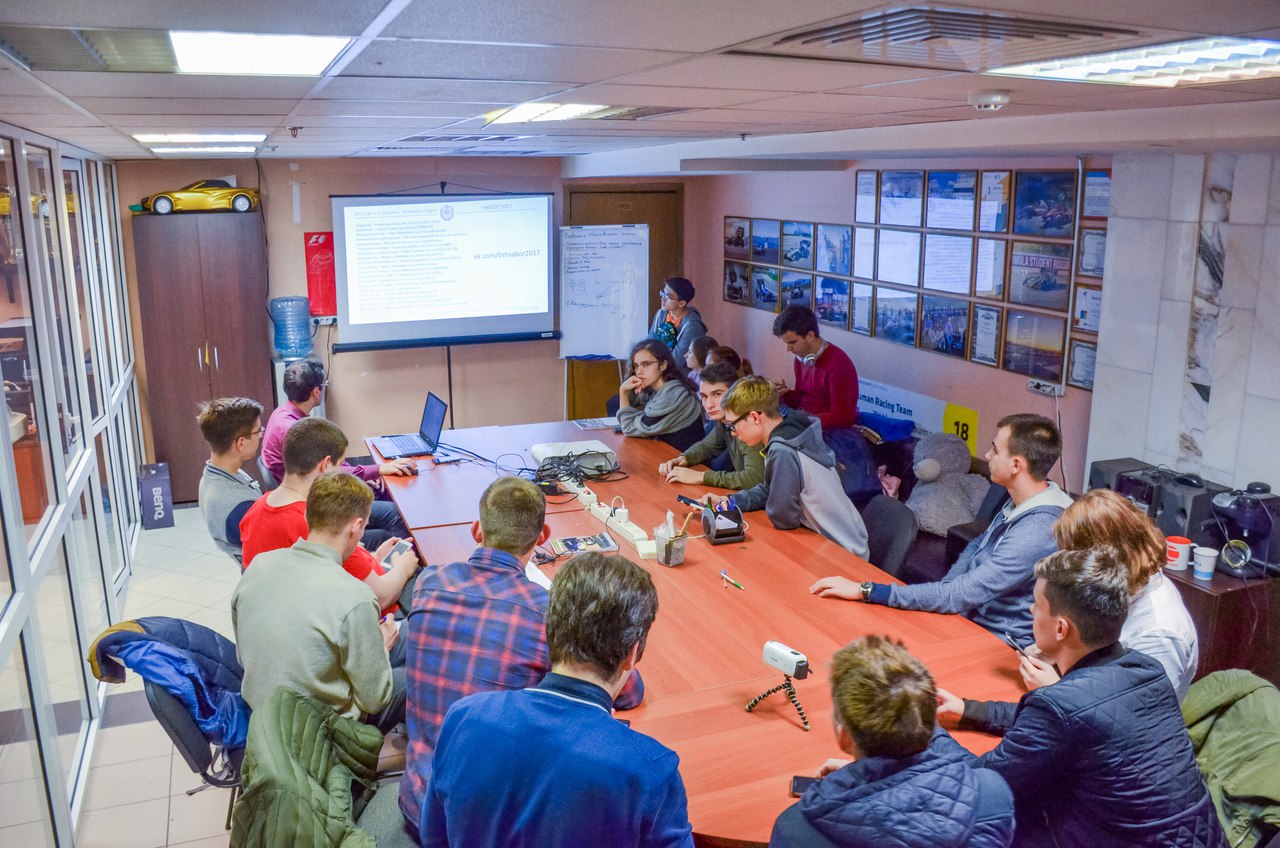
✎ Co-author of the text vsevolod_grigorev

Every year new guys come to our team with a desire to put the theoretical knowledge in the field of mechanical engineering into practice. We have formed the updated Bauman Racing Team for participation in the Formula Student competition at the beginning of the 2016/2017 academic year. Of course, we still have participants from past years who have learned a lot and are able to share experience with newcomers. Those in the team - 20 people. Always ready to help with practical advice and graduates. To get into the team, one desire is not enough. We have a kind of "qualifying" selection. In addition, new members of the Bauman Racing Team must perform a test task - to make or design any part in modern tools (for example, Siemens NX). To those who pass this stage, we are ready to show (or help to improve qualifications) how to use PLM technologies: for example, to create an electronic product mock-up (EMR), as we were taught by partners from LANIT.

This is our big team, and for the head of the Bauman Racing Team Dmitry Onishchenko (in the first row to the right) - also the family. The two children in the photo are his son and daughter.
')
Sleight of Hand and Digital Design
After updating the team, we started to create a new car, which at first was not too similar not only to a racing car, but also to a vehicle in general.



The volume of materials and the number of purchased products (bolts, nuts, rivets) would be difficult to predict in advance if we did not have a digital model. By the way, digital technologies make it possible to determine many different nuances without the need to conduct experiments: for example, you can calculate the total weight of plastic parts or the weight of a wire winding, test the machine components and suspension lever for strength, and also find out how the parts behave on different types of roads.


Again, modern technologies helped us to predict the behavior of individual machine systems. We simulated the reaction of the chassis to the various actions of the pilot, the effect of these actions on the engine and the entire electrical circuit. Without creating a digital twin, it would be impossible to do this. But the system created by us is not perfect and needs some work (why - you will read further).

Of course, for professional sports, it will be necessary to confirm the digital tests with full-scale experiments, but for the "Formula Student" we had enough of these calculations.
If the right improvised tool is attached to the digital technologies, then an experienced mini-production can turn out.

This year it took us 7 months to build a car from the “stocking” state. This is a month less than last year. And this is despite the fact that we did not use the capabilities of the PLM system 100%. There are still several training cycles planned from LANIT for requirements management and collaboration modules, but this is not the case now. As a basis, we took the previous version of our car. By optimizing some of the nodes and adding digital calculations (strength of parts and structures), we’ll get the same digital counterpart of our new car.


Actually, thanks to this, we managed to reduce the production time: the system allowed us to create a physical object in a virtual environment in a single digital platform. We could see each other's work and make edits at all stages of creating a car.
And our car is ready to go to the Formula Student competition in the Czech Republic - Formula Student Czech Republic .

It remains to settle the organizational issues and do what is always postponed for “later” - to weld the jack.

The jack is needed for the convenience of car maintenance before starting or in line. Thanks to him, you can, without exerting additional effort, access to any parts of the car. The design of the jack is a flight of imagination of future engineers, since it does not have special requirements for loads and safety.
As soon as the preparations were over, we plunged our car into a "technical" and moved to the Czech Republic.

Czech Republic, welcome guests!
We were waiting. The organizers and volunteers did a great job to make more than 500 team members feel comfortable from early morning until late at night: they prepared the track and boxes for the participants to live in.

 A source
A sourceThese sunny guys met 37 teams in the 1C category (Poland - 6 teams, Czech Republic - 6, Germany - 6, England - 4, Russia - 3, Greece - 2 and one each from Turkey, Serbia, France and Hungary) and 14 teams in categories 1E (Germany - 6, Italy, Spain, Portugal, Belgium, Czech Republic, Estonia and Finland - one by one).
Why such a categorical?
Formula Student teams can participate in three categories. The number indicates the level of training of participants:
1 - teams with physically existing machines that can move independently;
2 - teams with physically existing machines that, for one reason or another, cannot move on their own within the framework of the competition (for example, if they did not pass a technical inspection or the car broke down before the races);
3 - teams with concepts of the machine that they build for the next season, for example.
In addition to the numbers in the designation of the category there are letters:
- combustion - vehicles with internal combustion engine;
E - electric - cars, respectively, with an electric motor;
D - driverless - a new class - cars without drivers. But there were no such competitions in the Czech Republic.
1 - teams with physically existing machines that can move independently;
2 - teams with physically existing machines that, for one reason or another, cannot move on their own within the framework of the competition (for example, if they did not pass a technical inspection or the car broke down before the races);
3 - teams with concepts of the machine that they build for the next season, for example.
In addition to the numbers in the designation of the category there are letters:
- combustion - vehicles with internal combustion engine;
E - electric - cars, respectively, with an electric motor;
D - driverless - a new class - cars without drivers. But there were no such competitions in the Czech Republic.
As we wrote in the previous article, the level of training of teams and their technical equipment are completely different. Everyone chooses design tools (CAD) convenient for them, calculation tools (CAE), few use system engineering tools to predict machine behavior (1D). All somehow study modern tools, collaboration platforms (PDM), but due to very tight deadlines, not everyone is willing to waste precious time on the introduction of these technologies. In our experience, we can say that the introduction on our own is a disadvantageous undertaking. Only together with our partners, we were able to overcome the barriers (the complexity of self-study, laziness, lack of understanding of the feasibility of implementation) and save time and nerves of our children.
 A source
A sourceWhat was the stage for us in the Czech Republic? On the first day, everyone was assembling the cars and preparing for the technical inspection scheduled for the next day.

A source


A source
Sometimes fatigue prevailed. But the thing had to finish.

The second day began with the preparation of machines for technical inspection. I had to even knock in line.
 A source
A sourceTogether with us, the guys from Estonia and Germany “sunbathed”.

Later in the evening, we still reached the technical inspection. The judges made three small observations (and nothing to talk about), which we eliminated in an hour.

Separately, cars were checked for noise. This is where the jack came in handy:

The noise test is one of the obligatory stages of technical inspection. According to the regulations, the car on the paddock - a special place for the deployment of motor command teams - must move without the engine turned on, and in order to transport it, you need a “quick jack”. This testing can also be modeled using the digital twin. Products from CD-Adapco ( now included in the Siemens PLM Software product portfolio ) allow for acoustic analysis. But we have not yet reached such a degree of automation.

An important test is to roll over. The car on a special device is tilted at an angle of 45 degrees and the presence of leaks in the systems is observed. After that, the angle of inclination is increased to 60 degrees in order to check the weight distribution and stability of the machine.


Sometimes it is useful to look at the world from a different angle.
After the completion of technical checks, everyone began to prepare for dynamic disciplines. But first it was necessary to overcome a series of static tests - Design Event, Cost Report and Business Plan Presentation.
During the Design Event it is necessary to prove to the judges that the solutions applied are justified and better than those of all other teams. This is a task for engineers.

And while technical experts substantiate the modernization of automobile units, the marketing department’s “team” submits a business plan to the jury - often professional automakers. Under the terms of the competition, calculations must be made for the production of thousands of machines made from scratch using the technologies that the team applied.

A source
These are competitors. But we also stood before the judges, only so busy with the work that the photos did not. Some participants used virtual reality technology. In the helmet of the judge do not look so strict.

A source
After completion of all technical checks and static tests, the most entertaining part of the competition begins - dynamic disciplines and race.
 A source
A source
A source
The first stage is the acceleration test. Our car showed good results: acceleration of 0-100 km / h - 4 seconds. The maximum speed is 170 km / h. And this with a weight of 200 kg. When compared with the BMW M3 ... However, it is better to see once:


A source
With such support, contestants sought to squeeze the maximum out of the car. While on one track they were speeding up, on the other - the G8s were winding up. When both disciplines ended, the organizers took a break to build an autocross track, which served as a pass to the world of “big sports” - a race for endurance.

A source
By the way, the pilot of our car is also a Bauman student, as required by the rules of Formula SAE, a kart driver with a long track record. We offer a test to everyone who comes to us for a pilot’s job: if you overtake our pilots, let’s drive the car.
In the endurance race, our car showed excellent lap times.
Unfortunately, on the sixth lap, the cooling system hose could not stand, the water splashed out onto the hot engine, releasing a spectacular column of steam, and in the absence of cooling the oil system and the entire engine began to overheat. The result - we got off the track. By the end of the day the winners were determined.

A source
The team from the University of Brno, Czech Republic won in our class. Unfortunately, we were left without awards.

A source
Hello capital!
We met with colleagues from Czech Brno at the Formula Student Moscow stage, which took place in late September in the capital Gorky Park. A total of 10 Russian teams and two foreign teams participated - in addition to Brno, a team from Tallinn (Estonia) came to Moscow. Unfortunately, their cars remained at the border, and the teams participated only in static disciplines.
The first day of the competition was traditionally assigned to the technical inspection. We again passed the technical inspection one of the most recent. The cars were examined by former participants of the world's best Formula Student teams — Delft and GFR. No one expected it to be easy. Nevertheless, although we started last, we were one of the first to complete the inspection and began to calmly prepare for the next day, where static disciplines, acceleration tests and autocross waited for us. Due to the nature of the route, the organizers had to cancel the G8.

The next day, the acceleration test began right from the territory of the team boxes, which gave a special piquancy to the start and made it, in my opinion, the most spectacular among all the Formula Student events. We took the second place, and in the autocross - the third. The protection of the structure was a little worse, but thanks to the cost report, the third step of the pedestal became ours.
Final day of competition. The main event is a race for endurance. A feature of the track for this competition was its length and configuration - only 200 meters and almost an oval, in which the pilots had to cut 30 laps, fighting not so much for the best time, but with boredom.

But everything turned out exactly the opposite. Check-in was very dynamic, and the gathering was recorded only for the team from Belgorod. Our car showed excellent results on the circle. On one of the bends, part of the front wing of the car touched a cone: the wing broke down and broke off. The organizers noticed a breakdown only after a few laps, the arrival for forced repairs and the decision of the marshals to release us back onto the track took too long - as much as 50 seconds! This was another item in our "knowledge base" (Teamcenter), for the subsequent more detailed calculation of the design of the wing. Since we have set up a connection between the design model (NX) and the calculated one (Simcenter), it will be much easier for us to calculate this node in detail and take this error into account when creating the next machine.

As a result, the leader was the team of the Peoples' Friendship University of Russia, we received well-deserved silver, and the bronze went to the students of the Moscow Polytechnic University.


Competitions are over, and we are recruiting a team again. Very soon, work will begin on a new car, but for now the guys are learning, studying Teamcenter, NX, performing test tasks and thinking about how to improve the car.
We can not just save the experience gained in these competitions in memory or on paper, but we can add it to our platform created on Teamcenter. For example, we added information about the cooling system hose (which let us down a bit) to the electronic layout of the car. When designing the next car, we will not forget to strengthen it, regardless of whether the new team member or our experienced "fighter" will be responsible for this part.
I hope that we will continue to delight you with our results, talk about our experience in learning new technologies with the help of our partners and LANIT in particular, and talk about the application of these technologies in combat practice.


✎ Co-author of the text vsevolod_grigorev
Source: https://habr.com/ru/post/340842/
All Articles